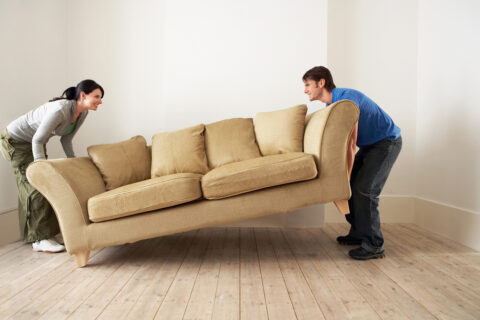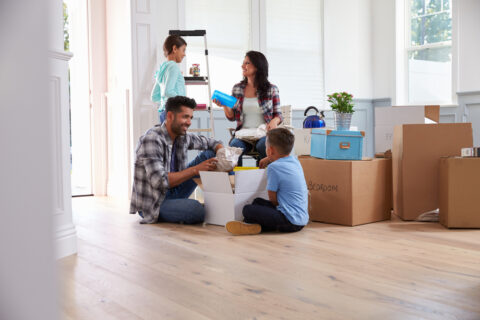The organization of the family and living rooms after relocating is an important task because it is the center of family entertainment, relaxation and recreation. In some homes, the family and living rooms aren’t two separate rooms; but in older houses, the family room was for relaxation and the living room was used for formal entertaining. Whether you have two separate rooms or just one, this article will help you organize these complex spaces. Work your way through each zone, starting with the area with the most traffic to the one with the least.
Electronics/Entertainment Center:
This area is the focal point of the room and the center of entertaining your family and guests. Before organizing this area, ask these questions:
– How many components do you want to include in your entertainment center? TV, cable box, Internet wireless router, DVD players, video came consoles, etc.
– How many CDs, DVDs and VHS tapes do you own and how many do you buy a year?
– Will the stereo and speakers be stored with the TV and is it part of a home theater system?
– Do you prefer to keep the electronics hidden?
– How much wall and floor space is available for the entertainment center?
– Will you need to make connections to computers or other devices?
An entertainment center is the best way to organize your various media and entertainment pieces. Usually, the placement of the entertainment center will be dictated by cable wiring and electrical outlets. To ensure the best use of space, make sure to measure the area. Entertainment centers usually come equipped with shelves or drawers to store CDs, DVDs and video games. If the entertainment center does not offer shelving or drawers, you can add standalone storage or shelves along the wall. Keep equipment and accessories as close to each other when not in use, for example, controller by the console and TV remote close to the TV.
Entertaining Area:
This space is defined by a couch, coffee table and surrounding chairs. The coffee table is the center of the room, which is a natural place for food, beverages, books and magazines. When searching for a coffee table, consider what style you would like, how many people will be using it and whether you would like additional storage.
Reading Area:
If you would like a separate area for reading, put a comfortable chair, reading light and a small side table to create this space. To avoid clutter, the table should be just enough for a beverage and a book.
Shelves:
Shelves in a living or family room are commonly devoted to books, but can be used for other storage as well. Follow these general rules of what to place on shelves:
Have a purpose – Individual items must have a reason for being on the shelf. A picture is there to be displayed. Your eye glasses shouldn’t be there nor should a pile of mail.
Collect to declutter – Individual items that are part of a collection should be grouped together in their own section of a shelf.
Contain when possible – Some items you might like to put on a shelf are best kept within a box or other container.
Fireplace and Mantel:
This area turns into a casual resting place , which tends to invite clutter. It is important to keep this area clutter-free and keep items that are used in the fireplace nearby. The brick area around the fireplace should only be used for fireplace accessories and decorative urn or sculpture. Keep wood tidy in a large fireproof basket, tin bucket, metal cradle or canvas satchel enough for one fire. For the mantel, use it as a showcase for one or two of your decorative (fireproof) pieces. The less there is on the mantel, the more items will stick out that don’t belong.
Chests, Side Tables and Supplementary Furniture:
Now you have your living and family room in order, but you still need to determine what additional storage is needed and what other types of furniture you may want to add to complement the socialization, entertainment or relaxation. Chests are a great way to provide long term storage, a place to sit or a surface for decorative items or lighting. Side tables and end tables are useful additions to the family and living rooms for their surface, drawer or shelf space they provide. A small trolley or caddy bar is great for entertaining, but should be able to fit neatly in the corner when not in use.
Windowsills, Pianos and Other Flat Surfaces:
These surfaces tend to be a temporary resting places for items, which can cause clutter. There are two strategies for keeping the clutter away: No vacancy rule – nothing is allowed on these surfaces at all times and creating a focal point, which will showcase the area and prevents items from being put in that area.
Keeping Up:
Two for one – Integrate your clutter check as part of the regular dusting and vacuuming. Return anything out of place to its proper location.
Periodic Update – Once a month, check the magazines and catalogs on your coffee table and recycle those that are out-of-date.
Disc Order – Every few months make sure that your CDs, DVDs and video games aren’t piling up. If you need more storage, you may have to add an extra tower or rack.
Come back on Tuesday, August 12 to organize the dining room area of your home.



